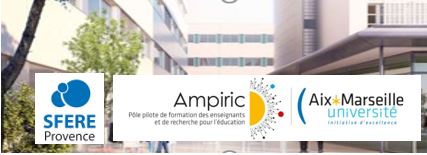RÉSUMÉ
Notre communication rend compte d'une étude (Essonnier, 2018) sur la conception collaborative de ressources mathématiques numériques innovantes pour développer la pensée mathématique créative de leurs utilisateurs, dans le cadre du projet européen MC Squared (2013-2016, http://www.mc2-project.eu/). Les ressources sont innovantes dans le sens où elles sont le résultat d'un processus de créativité sociale (Daskolia, 2015) entre les concepteurs. Cette conception a reposé sur le postulat que plus la créativité sociale est élevée entre les concepteurs plus le potentiel à développer la pensée mathématique créative des ressources créées est également élevé. Elle a été effectuée au sein d'une communauté d'intérêt (Fischer, 2001) dont le potentiel créatif est supérieur à celui d'une communauté de pratique (Wenger, 1998) selon Fischer (2001). Nous soulignons que les membres d'une communauté d'intérêt possèdent diverses expertises professionnelles. Notre communauté d'intérêt rassemble des ingénieurs, des techniciens, des enseignants et des chercheurs. Ces derniers sont réunis temporairement, simplement le temps de résoudre un problème, en ce qui nous concerne un problème de conception. Afin de mettre en avant des facteurs freinant ou favorisant la créativité sociale lors de ces conceptions, nous avons utilisé la théorie de l'activité et plus particulièrement la structure d'un système d'activité (Engeström, 1987), les concepts d'objets frontières (Star & Griesemer, 1989) et le franchissement de frontières (Akkerman & Bakker, 2011). Notre méthodologie est basée sur la décomposition de la créativité sociale en composantes. Nous avons pu mesurer la créativité sociale de façon consensuelle, en fonction de ses composantes en accord avec les travaux de Hennessey et Amabile (1999). Nos analyses, quantitatives et qualitatives, nous ont permis de mettre en avant des facteurs impactant la créativité sociale tels que la diversité, la division du travail et son organisation, les règles mises en places au sein de la communauté et les outils de communication entre les concepteurs, que nous détaillerons dans notre communication.
MOTS-CLÉS
Pensée mathématique créative, créativité sociale, collaboration, ressources numériques, communauté d'intérêt
ABSTRACT
Our communication reports on a study (Essonnier, 2018) about the collaborative design of innovative digital mathematical resources aiming at developing the creative mathematical thinking of their users, within the framework of the European project MC Squared (2013-2016, http: // www. mc2-project.eu/). These resources are innovative in the sense that they are the result of a social creativity (Daskolia, 2015) process between the designers. This design was based on the premise that the higher the social creativity between designers, the greater the potential to develop creative mathematical thinking of the designed resources. It was carried out within a community of interest (Fischer, 2001) whose creative potential is greater than that of a community of practice (Wenger, 1998) according to Fischer (2001). We emphasize that members of a community of interest have diverse professional expertise. Our community of interest brought together engineers, technicians, teachers and researchers. They were working together temporarily, just the time to solve a problem, in our case, a design problem. In order to highlight the factors hindering or fostering social creativity during the design process, we used the activity theory, and more particularly, the structure of an activity system (Engeström, 1987), the concepts of boundary objects (Star & Griesemer, 1989) and bordary crossing (Akkerman & Bakker, 2011). Our methodology is based on the decomposition of social creativity into components. We were able to measure social creativity in a consensual way, according to its components in accordance with the work of Hennessey and Amabile (1999). Our quantitative and qualitative analyses have enabled us to highlight factors impacting social creativity such as diversity, the division of labour and its organisation, the rules put in place within the community and the communication tools between designers, which we will detail in our communication.
KEYWORDS
Creative mathematical thinking, social creativity, collaboration, digital resources, community of interest
REFERENCES
Akkerman, S. F., & Bakker, A. (2011). Boundary Crossing and Boundary Objects. Review of Educational Research, 81(2), 132-169.
Daskolia, M. (Dir.) (2015). D2.4: A refined theoretical framework on social creativity in the design of digital educational resources for CMT. Public report, Mathematical Creativity Squared, FP7 – ICT, Grant Agreement no: 610467.
Engeström, Y. (1987). Learning by expanding: An activity. Theoretical Approach to Develomental Research.–Helsinki: Orienta–Konsultit.
Essonnier, N. (2018). Etude de la conception collaborative de ressources numériques mathématiques au sein d'une communauté d'intérêt. Thèse de doctorat. Université C. Bernard-Lyon 1, France.
Fischer, G. (2001) "External and Shareable Artifacts as Opportunities for Social Creativity in Communities of Interest," Proceedings of the Fifth International Conference on Computational and Cognitive Models of Creative Design (University of Sydney), Key Centre of Design Computing and Cognition, pp. 67-89. http://l3d.cs.colorado.edu/~gerhard/papers/ccmcd2001.pdf
Hennessey B. A.&, Amabile T. M. (1999).Consensual assessment. In M. A. Runco, & S. R. Pritzker (Eds.), Encyclopedia of Creativity (pp. 34–36). New York: Academic Press.
Star, S. L., & Griesemer, J. R. (1989). Institutional ecology, ‘translations' and boundary objects: amateurs and professionals in Berkeley's Museum of Vertebrate Zoology, 1907-1939. Social Studies of Science, 19, 387-420.
Wenger, E. (1998). Communities of practice: Learning, meaning, and identity. Cambridge university press.

 PDF version
PDF version
